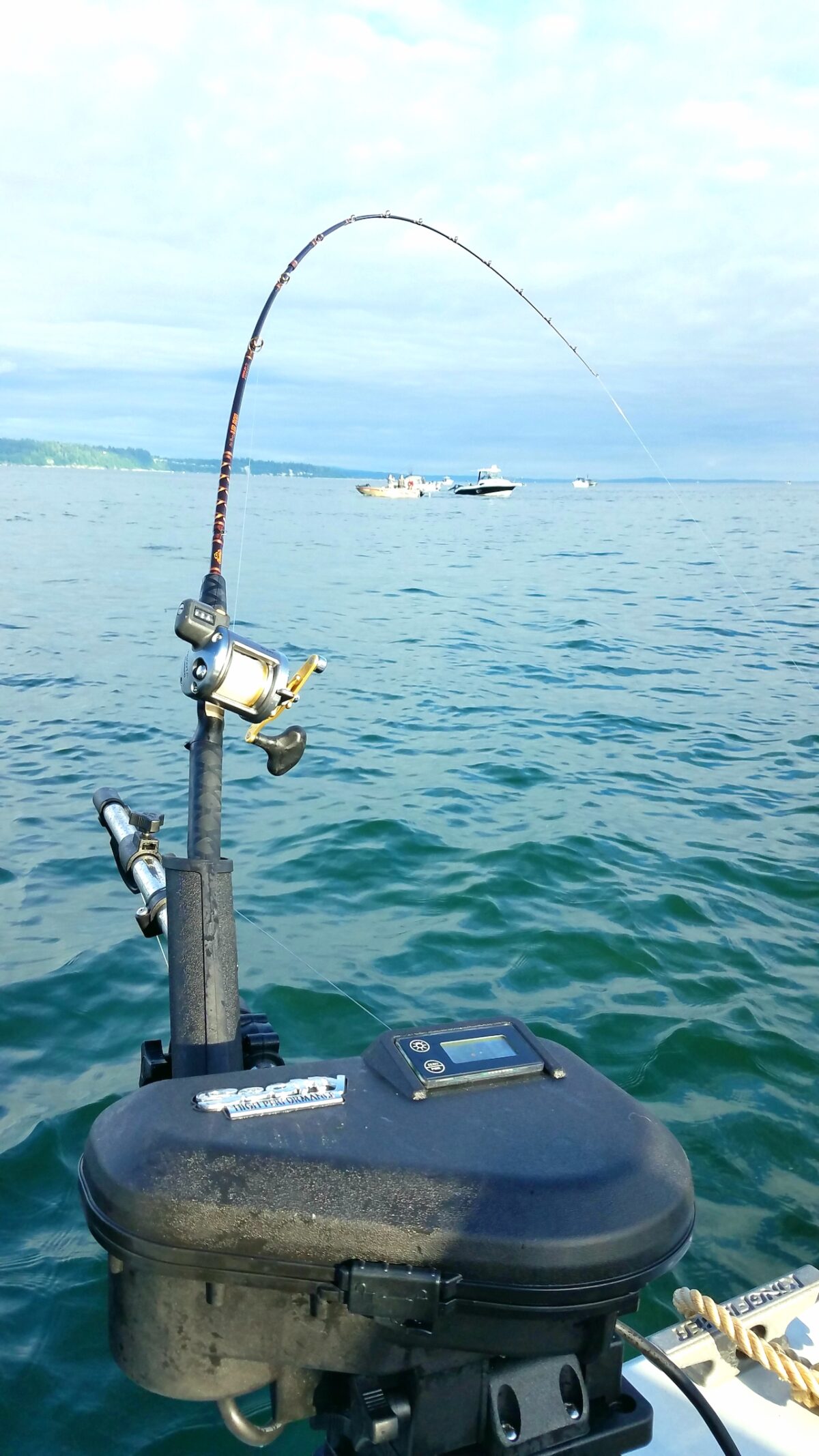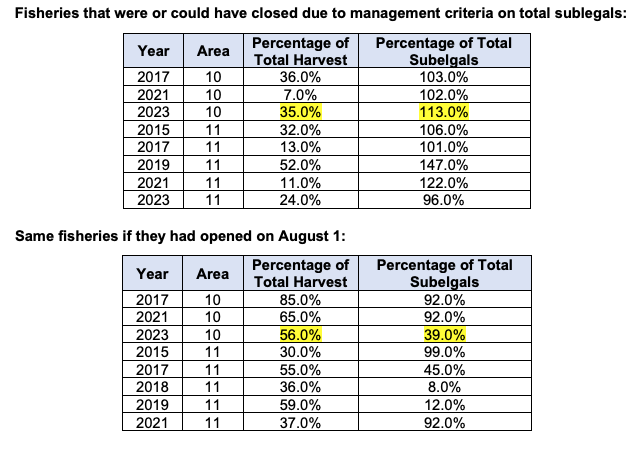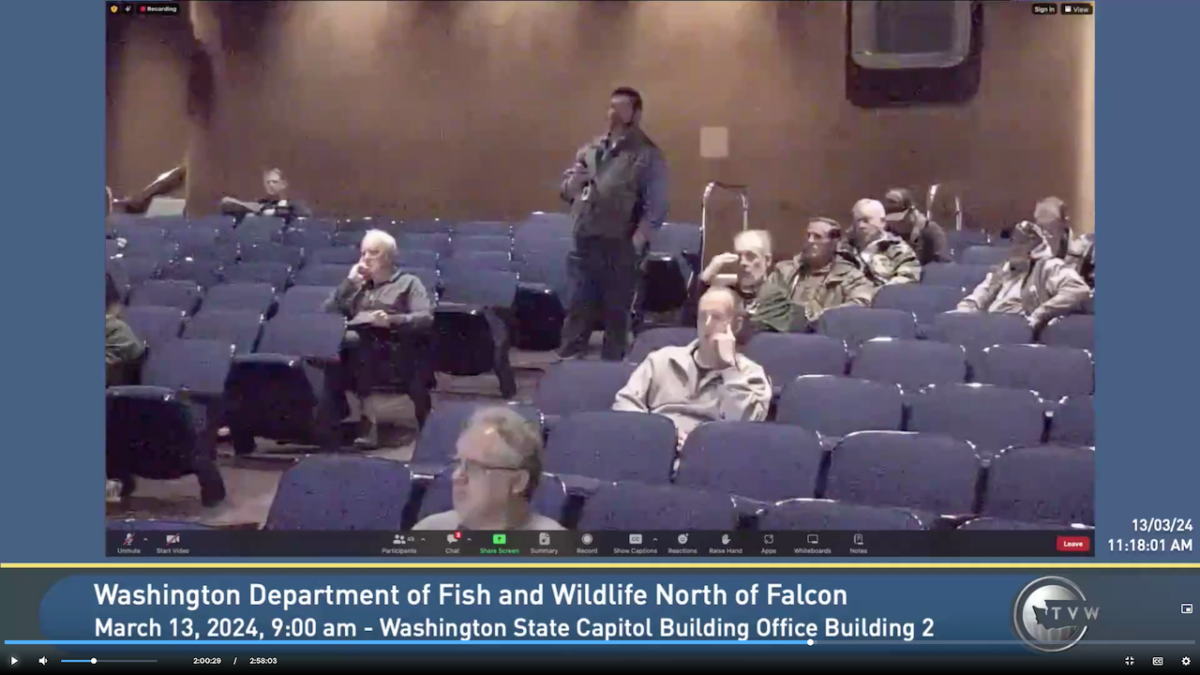
WDFW Talks Area 10-11 Chinook Proposal, Snohomish Wild Kings With Anglers
Washington salmon managers this morning rolled out a proposed new way to manage summer Chinook seasons off Seattle and Tacoma to try and avoid the early shutdowns and interrupted fisheries that deeply frustrated anglers last year.

Fishing on Marine Areas 10 and 11 was paused following high catches of sublegal fish, which left 2,559 harvestable hatchery kings on the table in the latter area, and so during today’s Puget Sound North of Falcon meeting with anglers, WDFW took feedback on setting the opening date for both waters to August 1 and conducting test fishing in July to assess the abundance of those too-small-to-keep Chinook.
When the proportion of legal-sized kings seen in test data approached preseason modeling in what’s known as the FRAM, or Fishery Regulation Assessment Model, the waters could then be opened early through emergency rule change notices
But if the ratio wasn’t in line with expectations, the fishery wouldn’t open till August 1.
“This effectively acts as a type of in-season update on the presence of sub-legals in the catch area and tries to avoid them on high sub-legal years relative to the FRAM prediction,” a WDFW handout explained. “Delaying the seasons on sub-legal years can have a large impact on the amount of retained fish.”
The one-pager shared this chart:

At this point it’s all a proposal and would chop an on-paper month out of Tacoma’s summer Chinook fishery and two weeks out of Seattle’s, but there is a fair amount of key support for it.
Still, Gabe Miller, a local angler and Sportco’s buyer, wondered if the opening date could be moved up to July 25 because it might be “bad optics to lose all of July” off the Clay Banks, Owen Beach and other popular Area 11 waters.
WDFW salmon manager Mark Baltzell said it was just one of several ideas the agency wanted to put out there to address Central and South Sound issues, but the nut of it is to try and keep areas open during periods of peak Chinook abundance. From what they’ve heard from anglers, the less disrupted salmon seasons are, the better, he said.
The meeting also featured a lot of focus on North Sound wild Chinook runs, including Nooksack springers, Skagit summer/falls, the always-constraining Stillaguamish kings, and in particular Snohomish wild Chinook, and what the management objectives will be for them. Objective is another way to say how many can acceptably be killed while prosecuting seasons over stronger hatchery stocks.
Using what’s known as NALF modeling, or combining this year’s new abundance estimate with last year’s fisheries, fall kings returning to the Snohomish’s southern tributary, the Snoqualmie, are in what’s known in the Puget Sound Chinook management world as the lower bound threshold, a bad place to be, especially with north of 14,000 hatchery summer kings headed to the Snohomish’s northern branch, the Skykomish.
Derek Dapp, WDFW’s chief salmon modeler, again warned that most likely, 2024’s fisheries would look similar to 2023’s, which were heavily restricted for not only Chinook but summer steelhead, pink salmon and coho.
Doug St. Denis, president of the Washington State Guides Association, wondered if there was any concern about allowing for the potential of so many hatchery kings to spawn with wild fish on the Skykomish. WDFW Regional Manager Edward Eleazer pointed out that because they’re an integrated stock, there could actually be some benefit to that.
How restricted things end up on the Sky and the rest of the system this spring, summer and fall will depend on 1) the final management objective for Snohomish wild Chinook agreed to with local tribal managers and 2) how many impacts can be shaved out of in-river, Puget Sound and Washington Coast fisheries.

With WDFW scheduled to meet with their comanager counterparts behind closed doors tomorrow to start comparing potential fisheries, retired agency staffer Pat Patillo implored his former coworkers to put Marine Area 7, 8-1 or 8-2 blackmouth fishery placeholders into their proposal as a way to send strong messages that they support the opportunities, which have been massively trimmed back, and that there’s “not something evil” about the winter fisheries for feeder Chinook.
Thinking out loud more than anything, Dapp wondered whether there might be a potential impact-neutral transfer of blackmouth from Area 5 to the 8s but pointed out that a winter fishery could have a higher cost in terms of Stillaguamish and Snohomish Chinook and thus be tougher for local tribes to get behind.
As North of Falcon continues, WDFW has again posted its Chinook fishery analysis tool, an Excel sheet that allows you to see how various ocean, inside and in-river season permutations impact the aforementioned stocks of concern.
Norm Rinehart of the Kitsap Poggie Club asked for an update on discussions to reopen the lower Skokomish, closed to state anglers since the mid-2010s because of a boundary dispute with the Skokomish Tribe that has locked up access to a plentiful hatchery run. He called for creativity in reopening some sort of fishery.
Earlier this month, it was announced that WDFW Director Kelly Susewind was meeting with the tribal chair on fisheries, but Baltzell said he didn’t have an update on discussions though he believed a proposal had been shared.
“My gut’s telling me we’re not there this year,” he added.
Coho were also on today’s agenda, and retired North Sound fisheries biologist Brett Barkdull called for more opportunity to chase them in Area 8-1 – a stronger Skagit wild run is forecast – and the Stillaguamish, and others asked for a chance to chase silvers in October in Area 9 and earlier in the season in the eastern Strait of Juan De Fuca.
The Area 9 fishery was scaled back to help rebuild Snohomish coho after they were federally listed as overfished, but with the stock now officially rebuilt, Baltzell said that given this year’s abundances, it would be something that could be looked at.
Another angler trolled the idea of switching the Central Sound early resident coho fishery to shore-only to reduce impacts on young kings, which was essentially the idea behind another retired state fisheries bio’s idea to give anglers fisheries credit for using large plugs for Chinook.
Coming out of Thursday’s meeting with the tribes, WDFW plans to post initial fishery proposals for public comment.
“This part of the process is very important to us, and we want to maximize as many opportunities (for public input) as we can for everybody,” Baltzell said in an agency blog update summarizing today’s meeting.
Next up on the public docket is a March 19 meeting to go over coastal freshwater and Puget Sound proposals. It begins at 6 p.m.
